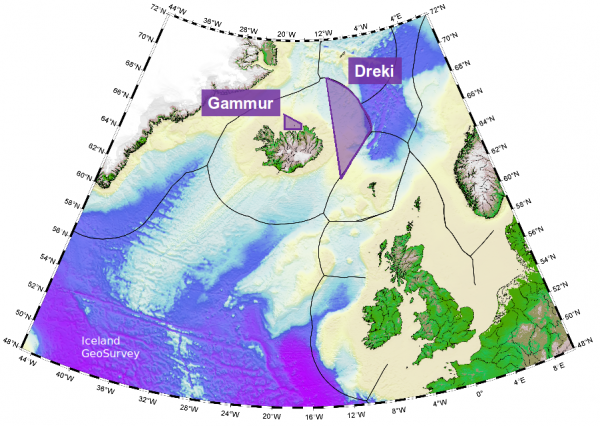Search for oil or gas in a part of the Dreki region in the north-east part of the Icelandic continental shelf has been stopped after the exploration companies concluded that source rocks which might contain hydrocarbons are at a greater depth than originally hoped.
Exploration is still ongoing in one part of the Dreki region. Prospectors are still very optimistic oil will be discovered in Icelandic waters.
Read more: Iceland meets only 0.01% of it's electricity needs with fossil fuels, 99.99% from renewables

The exploration companies, a Canadian company Ithaca Petroleum, and two Icelandic companies, Kolvetni ehf and Petoro Iceland ehf have their exploration licenses to the National Energy Authority which grants exploration licenses. Petoro is still engaged in oil exploration in a larger area to the south of the region where search has been stopped.
More oil than Norway?
Heiðar Guðjónsson, the chairman of Petoro, told the local TV station Stöð 2 that the company and its partners, the Icelandic company Eykon and the Chinese oil giant CNOOC are optimistic they will discover oil. He added that the area might potentially contain more oil than the Norwegian oil fields in the North Sea.
The license which was relinquished yesterday is one of three exploration licenses granted in the Dreki region in 2013 and 2014. The first license was returned last year, leaving only the license granted to CNOOC, Petoro and Eykon still valid. Research in this area will continue for at least a year.
Read more: Gold prospectors interested in Icelandic geothermal areas
Oil and gas exploration in Iceland?

The three areas in Icelandic waters where oil and gas exploration has taken place are located in the Dreki region, which includes the southern tip of the Jan Mayen microcontinent. Based to its geological similarity to nearby sites containing oil and gas in the Northeast Atlantic Ocean basin the Jan Mayen Ridge is believed a likely site of oil or natural gas deposits.
A number of surveys have been made in the northern part of the Dreki Area, indicating the presence of thick continental crust which might potentially include rock dating to the Jurassic and Cretaceous periods. Exploration is still ongoing in the final of three exploration areas in Dreki.
A second major area, Gammur, north of Iceland, is a relatively young sediment basin of about 9 million years, with a 4 km thick layer of sediments. Indications have been found of gas escaping the sediments. The source and nature of the gas has not been determined.
Search for oil or gas in a part of the Dreki region in the north-east part of the Icelandic continental shelf has been stopped after the exploration companies concluded that source rocks which might contain hydrocarbons are at a greater depth than originally hoped.
Exploration is still ongoing in one part of the Dreki region. Prospectors are still very optimistic oil will be discovered in Icelandic waters.
Read more: Iceland meets only 0.01% of it's electricity needs with fossil fuels, 99.99% from renewables

The exploration companies, a Canadian company Ithaca Petroleum, and two Icelandic companies, Kolvetni ehf and Petoro Iceland ehf have their exploration licenses to the National Energy Authority which grants exploration licenses. Petoro is still engaged in oil exploration in a larger area to the south of the region where search has been stopped.
More oil than Norway?
Heiðar Guðjónsson, the chairman of Petoro, told the local TV station Stöð 2 that the company and its partners, the Icelandic company Eykon and the Chinese oil giant CNOOC are optimistic they will discover oil. He added that the area might potentially contain more oil than the Norwegian oil fields in the North Sea.
The license which was relinquished yesterday is one of three exploration licenses granted in the Dreki region in 2013 and 2014. The first license was returned last year, leaving only the license granted to CNOOC, Petoro and Eykon still valid. Research in this area will continue for at least a year.
Read more: Gold prospectors interested in Icelandic geothermal areas
Oil and gas exploration in Iceland?

The three areas in Icelandic waters where oil and gas exploration has taken place are located in the Dreki region, which includes the southern tip of the Jan Mayen microcontinent. Based to its geological similarity to nearby sites containing oil and gas in the Northeast Atlantic Ocean basin the Jan Mayen Ridge is believed a likely site of oil or natural gas deposits.
A number of surveys have been made in the northern part of the Dreki Area, indicating the presence of thick continental crust which might potentially include rock dating to the Jurassic and Cretaceous periods. Exploration is still ongoing in the final of three exploration areas in Dreki.
A second major area, Gammur, north of Iceland, is a relatively young sediment basin of about 9 million years, with a 4 km thick layer of sediments. Indications have been found of gas escaping the sediments. The source and nature of the gas has not been determined.







